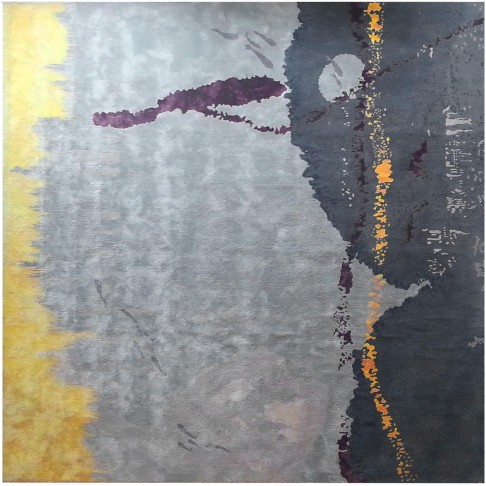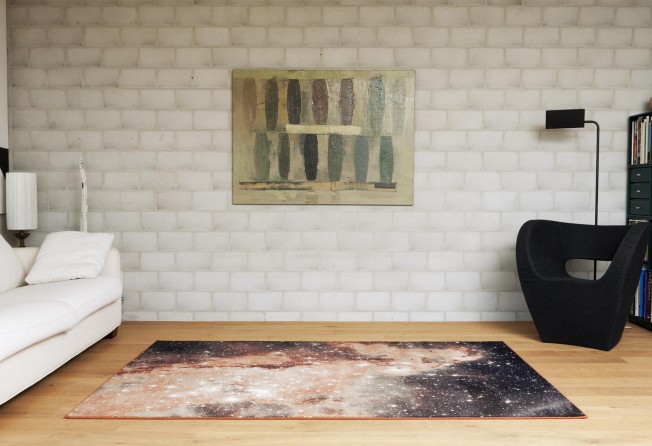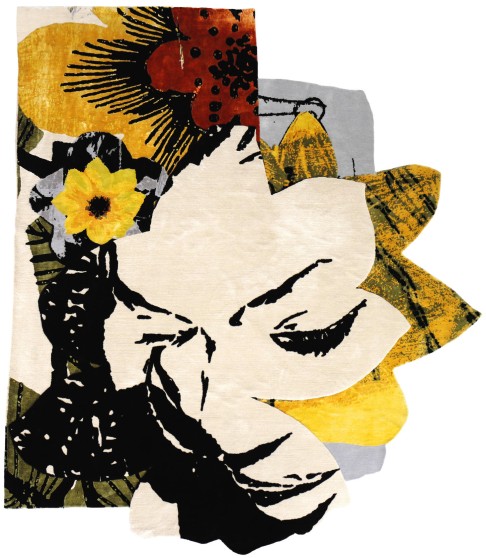
The latest trends in creative floor art
Dream Innovative carpet-making techniques coupled with inspired designs are driving trends in creative floor art, writes Catherine Shaw

The humble floor rug is enjoying a very modern renaissance led by a powerful combination of new technology, contemporary design and painterly inspiration.
The best brands blend modern technology with age-old carpet-making traditions, creating pieces that may cost the same as a painting or sculpture by an established artist. But this makes perfect sense as they perform double duty as practical floor coverings and unique decoration.
Innovative weaving techniques that enable ultra precise machine weaving has seen creative designers such as Zurich-based Schönstaub (literally "beautiful dust") translate photorealistic motifs, graphic elements and fine drawings into rugs.
Founders Nadja Stäubli and David Schönen, who met while at Zurich University of the Arts, turned to the hi-tech Swiss precision of Schönherr, a historic weaving company, to help make Nebula, a debut collection of rugs (US$2,190 for a 220cm x 150cm rug).
The rugs take about six months to make and feature celestial-inspired patterns using photographs of nebulas in the small and large Magellanic Clouds taken by the Hubble Space Telescope.

"I love working with collage because of the complexity and depth involved in the medium. It can be quite edgy and modern. I created the design on a computer, and had it made in China using 60 per cent exceptional quality silk. This gives it wonderful luminosity, and makes it very comfortable to walk on, too. I'm proud to say it was made in China, as the quality is excellent."
Earlier this year in New York, Henzel Studio collaborated with 12 artists on a collection of art rugs. The standout piece by New York-based artist Mickalene Thomas is a free-form rug made of Himalayan wool and silk and was handmade in Nepal.

It is not just younger brands that are embracing a contemporary aesthetic. Tai Ping, established in 1956, has expanded its range to reflect a newfound modern sensibility with contemporary art-inspired designs developed through collaborations with artists tasked with exploring the medium of rugs as an artistic canvas.
One of the most eye-catching is Tai Ping's vibrant Chroma collection, launched at the 2014 London Design Week. The distinctive abstract images look like hand-painted canvases with exuberant patterns and colours.
Beyond Touch I (HK$32,000; 200cm x 260cm), for example, features dramatic splashes of colour in delicate silk on a cream wool and flax background, and would look as good hung on a wall as on any floor.
At Art Basel Miami Beach last year, the company took the art of contemporary rug design a step further with a series of four circle rugs made in collaboration with Brooklyn design duo Chen Chen and Kai Williams. The quirky designs, a wild medley of colours, patterns and textures made with wool, flax, bamboo, and a delicate silk to produce a 3-D effect, were inspired by the designers' hand-made Cold Cut Coasters, boldly graphic artworks created by combining wood, resin and fabric.
Embracing the modern creative trend doesn't mean ignoring the past. Tel Aviv-born, Paris-based industrial designer Ramy Fischler's latest artisanal rug collection designs are an abstraction of traditional 18th-century Chinese ink paintings he discovered in an ancient book Livres de desseins chinois (Books of Chinese designs) by Jean-Antoine Fraisse.
The rugs were originally designed for the glamorous Parisian interiors Fischler created for Tai Ping's Hôtel de Livry showroom in 2012, but the compositions were such a hit they soon emerged as a range of their own. The collection (from HK$61,000 for 200cm x 260cm) is again the feature of the brand's new Shanghai showroom.
The original intention, says Fischler, was "to make a link between the historic architecture of the Parisian building and the showroom. A rug cannot be just decoration. There has to be some thinking behind it".
In Wong Chuk Hang, American husband-and-wife design team Janis Provisor and Brad Davis keep creative inspiration close to home, treating luxury rugs as a canvas for personal artistic expressions. The two are both accomplished contemporary painters with works exhibited in major American and European museums, including New York's Museum of Modern Art, the Metropolitan Museum of Art and the Germany's Museum Ludwig. After spending time exploring their art in Hangzhou in the late 1980s, they returned in the '90s and began using wild Dandong silk to translate their distinctive modern watercolour paintings into carpets.
The blend of creativity and craftsmanship proved so successful their company, Fort Street Studio, has gone on to create bespoke designs for the likes of Elton John, Brad Pitt, Madonna and, more recently a custom-designed range for French fashion house Hermès. The two artists have showrooms in New York and Los Angeles, while a new 5,000 sq ft loft studio showcases their collection of original watercolour designs painted for their inaugural rug collection in 1996.
Here, the recently released special-edition Luxe collection (from HK$280,000 for a standard size rug of 2.7 metres x 3.6 metres) catches the eye with three designs inspired by the carpets of 17th century Persian courts and the emperor's private quarters in the Forbidden City. The innovative pieces feature high knot counts and include Toll made of wild silk yarns, Geo, a geometric pattern in platinum or lemon, and Kuta, in a style of woven brocade.
Border is a captivating 100 per cent wild silk cream rug featuring a graphic gradated grey border that has a calligraphic brushstroke aesthetic.
Davis says the process of translating paintings into rugs took years of experimentation.
"We first tried to simply paint the design to be interpreted, but that was disastrous. Then we used a Xerox machine to break the image down into smaller particles. The real breakthrough in design came with computers. A pixel is a knot, and if you have the right resolution you can generate a knot-by-knot pattern of very difficult painterly effects."
Although today there are many dedicated software programmes that have become part of the carpet world, in the '90s the couple was at the forefront of developing new ways of using digital technology to generate high-definition usable patterns.
But digital technology only solves part of the problem. Achieving the delicate gradation and hues typified by watercolours is entirely dependent on the ability of dyers to produce subtle gradations in a single colour, a skill that has not been available until the fashion industry shared its expertise in this field.
"Dyers are the real heroes," says Davis. "It is one thing to generate a pattern, but another to actually create it. Modernism's contribution has been to bring information from one creative field to another. Here it has helped to blur the boundaries between art and carpets."